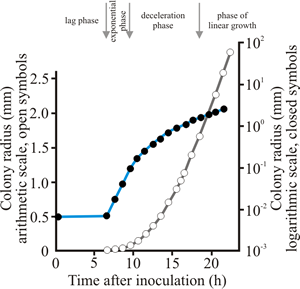4.5 Colony growth to maturity
A limitation of the observations we ha’ve shown you so far is that they deal with very young mycelia growing under unrestricted conditions. In the real world this situation can last for only a short time. Before too long, growth of maturing mycelia becomes affected by nutrient limitation, change in pH and growth inhibitors (metabolic waste products and secondary metabolites that the mycelium itself leaks into the medium). This is described as heterogeneous growth under restricted conditions.
If the growth of the culture is followed by measuring biomass such a growth pattern can be shown to occur in the conventional sequence of phases of growth of a culture of a unicellular microorganism: namely lag phase, exponential phase (growth occurring under unrestricted conditions), linear (= constant growth rate) and deceleration phases of growth, which occur as conditions become restricting. The linear phase can be the predominant phase in growth of filamentous fungi in nature, but the important point is that all phases can be demonstrated during filamentous fungal growth on a solid medium (an agar-solidified medium in the laboratory)(Fig. 10)(but see Chapter 17 for detailed discussion of growth kinetics in fermenters).
Growth of a fungus on a solid medium will result eventually in the establishment of conditions below the centre of the colony which are less favourable for growth than was initially the case. Such unfavourable conditions include nutrient depletion, changes in pH, and the production of secondary metabolites inhibitory to growth. Fig. 11 shows the gradient in glucose concentration established in the medium beneath and around a colony of Rhizoctonia grown on solid medium. The gradient results from glucose uptake by the fungus and diffusion of glucose from uncolonised to colonised parts of the substrate. Similar gradients are established for other nutrients, oxygen and pH.
 |
 |
|---|---|
| Fig. 10. Growth phases of Aspergillus nidulans colonies. Modified from Trinci, 1969. | Fig. 11. Glucose concentration in the medium below a colony of Rhizoctonia cerealis grown at 25°C on 20 ml of agar medium in a 9 cm Petri dish. |
Development of less favourable conditions for growth than those present at the start causes a deceleration from the maximum rate; this is known as restricted growth, and growth may cease eventually. Restricted growth is also brought about in some fungi by genetically programmed senescence.
Updated July, 2019
